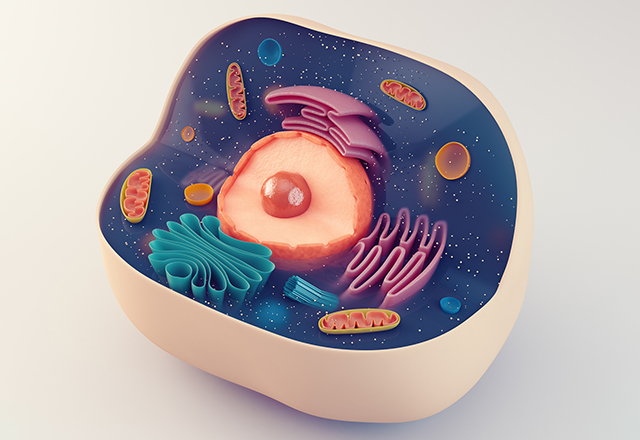“Powerhouse of the Cell.” That was a punchy headline. So punchy in fact, that Philip Siekevitz’s 1957 Scientific American article lives on to this day in public school classrooms and internet message boards. The headline, as so many headlines do, boils the subject down to a single simple idea. So simple that in 2013 the headline became a meme.
The 1957 Scientific American article was written as a way to boldly introduce the newly discovered role of mitochondria to the world. Since the turn of the 20th century, scientists knew that mitochondria existed in all cells, and some believed they played a role in providing energy to the cell. In the 1950s, more refined experimental methods allowed scientists to isolate mitochondria from the rest of the cell. Scientists were then able to demonstrate that oxidative phosphorylation, the chemical process cells use to store the energy ATP, occurs in mitochondria, thus earning them their famous title.
Re-branding the Mitochondria
The 2013 Tumblr post that made mitochondria internet famous strikes a tone of disillusionment with secondary school education. Its basic formula adds mitochondria’s role in the cell to the end of a list of more practical (though dramatized) life lessons. Juxtaposing the quippy fact against more concrete practical knowledge highlights the frivolousness of memorized trivia from our high school classes. It was a popular model, to say the least. The meme grew quickly, spurring numerous different iterations, and to this day enjoys an annual spike in popularity shortly after the beginning of each school year. But like all headlines and memes, the subject that they are attempting to describe or satirize, respectively, deserves more nuance than what pop culture is willing to give. Mitochondria are not just the powerhouse of the cell, and the fact that they are the powerhouse of the cell is not at all frivolous.
Work on mitochondria did not stop in the 1950s after it was named “the powerhouse of the cell.” Subsequent studies throughout the rest of the 20th century identified the mitochondria as an incredibly dynamic organelle involved in multiple cellular processes in addition to energy production. The modern view of mitochondria is one that is much less isolated from the rest of the cell than our high school cell diagram worksheets, or Philip Siekevitz, would have us believe. This is not necessarily the fault of the biologists and biochemists of the past. Mitochondria were largely studied in isolation from the rest of the cell, a necessity for cleaner, more interpretable biochemical experiments. But now, with advanced techniques, scientists are better able to study mitochondria in their living cellular context and observe their diversity of roles within the cell.
Erica Avery, a graduate student in the Cellular and Molecular Physiology Program, designed a class aimed at conveying the marvels of mitochondria to her fellow Ph.D. students. Outside of the obvious role of ATP production, Erica was able to rattle off a list of other crucial functions mitochondria execute that have been teased out since the 1950s. One of the main roles that would have been covered in college and grad school level cell biology classes is in apoptosis, a cell death pathway. But other, less-discussed functions of mitochondria include breaking down fats, generating the molecules used in DNA and acting as a buffer for calcium ions. Mitochondria are more than just the powerhouse of the cell, they’re a dynamic network of tubules that perform multiple essential functions. Erica pointed out to me that one of the first observations of mitochondria noted that they were found in every cell type in which scientists looked. Their ubiquity was a hint to their importance, an irony given that the ubiquity of the meme about mitochondria has made it feel like a useless bit of trivia.
Removing the mitochondria from their cellular context allowed scientists to make simple observations that distilled the organelle’s role down to one simple idea. Isolating mitochondria was necessary for the biochemical experiments used to decipher their role in ATP production, but that isolation resulted in an incomplete understanding of a complex organelle. In their isolation, scientists missed the context in which mitochondria live and interact with the rest of the cell in dynamic and essential ways. Similarly, memes strip an idea from its context, and in the case of mitochondria, label them as a useless bit of trivia relative to harder ‘life lessons’ learned in school. If the lesson of mitochondria is that alone they are important, but in the full context of the cell are even more important, then almost the inverse lesson is to be learned from the meme. While facts alone might seem useless, learning them in the context of school is not at all useless. School is about learning facts, but it’s also about learning how to exist in the world, building a community of peers, learning how to learn. In that sense, the “mitochondria is the powerhouse of the cell” meme misses the point of secondary education.
The story of the mitochondrion teaches us not to forget to understand the context of what we’re learning. The mitochondria are not just the powerhouse of the cell, they are dynamic, shape-shifting, calcium-buffering, nucleotide-synthesizing, fatty acid-burning, cell death-regulating meshwork that are integral to most cells. Context adds richness to every subject, whether it be mitochondria or useless trivia, and that richness is lost when we try to synthesize them down to a single simple idea.
Learn more about our school of medicine graduate programs.
Want to read more from the Johns Hopkins School of Medicine? Subscribe to the Biomedical Odyssey blog and receive new posts directly in your inbox.
Related content
- A Primer on Platelets — Tiny but Mighty
- The F-Word in Metastatic Prostate Cancer
- Considerations for the Manufacturing of Cell and Gene Therapies for Humans
